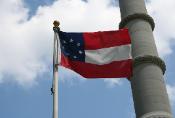

ExploreSouthernHistory.com - First Capitol of the Confederacy, Alabama
ExploreSouthernHistory.com - First Capitol of the Confederacy, Alabama

| First Capitol of the Confederacy The historic Alabama State Capitol in Montgomery holds the unique historical distinction of being the only U.S. state capitol building ever to host the formation of another nation. |
First Confederate Capitol
The Alabama State Capitol
building in Montgomery was
Capitol of the Confederacy
from February until May, 1861.
The Alabama State Capitol
building in Montgomery was
Capitol of the Confederacy
from February until May, 1861.

Jefferson Davis Star
A bronze star on the portico of
the Alabama State Capitol
marks the spot where Davis
was inaugurated in 1861.
A bronze star on the portico of
the Alabama State Capitol
marks the spot where Davis
was inaugurated in 1861.


Alabama State Capitol
Located atop uniquely named
Goat Hill, the capitol building
was the scene of the drafting
of the C.S. Constitution.
Located atop uniquely named
Goat Hill, the capitol building
was the scene of the drafting
of the C.S. Constitution.
First Capitol of the Confederacy - Montgomery, Alabama
Birth of the Southern Nation...

In February of 1861, delegates from seven
Southern states met in the Senate Chamber
of the then ten year old state capitol building
in Montgomery, Alabama. Each of these
states had declared its independence from
the United States and before their meetings
in Montgomery were over, they had joined
forces in establishing the Confederate States
of America.
In the words of the Alabama Historical
Commission, the Capitol Building is now a
"significant monument in American history." It
is the only state capitol building in the United
States that hosted the formation of a new
nation.
The so far bloodless revolution in the cotton
states had begun in December of 1860 when
South Carolina seceded from the Union
following the election of Abraham Lincoln as
President of the United States. Southern
leaders had warned that Lincoln's election
would lead to the destruction of the old union,
but a split in the Democrat party allowed
Lincoln to win the hotly contested campaign,
even though he carried less than 40% of the
more than 4,685,000 ballots cast.
The election of Abraham Lincoln sparked the
greatest constitutional crisis in American
history. South Carolina was quickly followed
in her decision to leave the Union by (in
order) Mississippi, Florida, Alabama,
Georgia and Louisiana.
Immediately realizing that none of their states
stood much chance against the power of the
Union alone, leaders from the six states
picked centrally-located Montgomery,
Alabama, for a meeting of delegates to
consider their joint future. Alabama officials
made available the Senate Chamber in their
capitol building.
The Southern Convention convened on
February 4, 1861, as large crowds gathered
outside and militia units paraded on Dexter
Avenue. Declaring themselves a provisional
legislature, the delegates established the
provisional government of the Confederate
States of America. In just four days they
drafted a provisional constitution, completing
their work on a final document on March 11,
1861.
The Constitution of the Confederate States of
America, drafted in Montgomery, was a
unique historical document. Although it was
largely based on the existing Constitution of
the United States, it did include language
regarding slavery. It should be noted that
slavery was then legal in areas other than the
Deep South and remained legal in parts of
the Union until after the Civil War had ended.
Additionally, however, the delegates clearly
specified the sovereignty of the individual
states. They also adopted language that
limited the powers of the central government
and gave its leaders different authorities than
those guaranteed in the U.S. Constitution.
The President of the Confederacy, for
example, could serve only one six-year term
(the U.S. Constitution then had no limit on the
number of terms a president could serve). It
allowed for cabinet members to hold seats in
Congress and, uniquely, forbade the
expenditure of national money for internal
projects. The Southern Constitution also
gave the President a line item veto over
budget matters, a power much sought after
by modern U.S. Presidents.
Southern states met in the Senate Chamber
of the then ten year old state capitol building
in Montgomery, Alabama. Each of these
states had declared its independence from
the United States and before their meetings
in Montgomery were over, they had joined
forces in establishing the Confederate States
of America.
In the words of the Alabama Historical
Commission, the Capitol Building is now a
"significant monument in American history." It
is the only state capitol building in the United
States that hosted the formation of a new
nation.
The so far bloodless revolution in the cotton
states had begun in December of 1860 when
South Carolina seceded from the Union
following the election of Abraham Lincoln as
President of the United States. Southern
leaders had warned that Lincoln's election
would lead to the destruction of the old union,
but a split in the Democrat party allowed
Lincoln to win the hotly contested campaign,
even though he carried less than 40% of the
more than 4,685,000 ballots cast.
The election of Abraham Lincoln sparked the
greatest constitutional crisis in American
history. South Carolina was quickly followed
in her decision to leave the Union by (in
order) Mississippi, Florida, Alabama,
Georgia and Louisiana.
Immediately realizing that none of their states
stood much chance against the power of the
Union alone, leaders from the six states
picked centrally-located Montgomery,
Alabama, for a meeting of delegates to
consider their joint future. Alabama officials
made available the Senate Chamber in their
capitol building.
The Southern Convention convened on
February 4, 1861, as large crowds gathered
outside and militia units paraded on Dexter
Avenue. Declaring themselves a provisional
legislature, the delegates established the
provisional government of the Confederate
States of America. In just four days they
drafted a provisional constitution, completing
their work on a final document on March 11,
1861.
The Constitution of the Confederate States of
America, drafted in Montgomery, was a
unique historical document. Although it was
largely based on the existing Constitution of
the United States, it did include language
regarding slavery. It should be noted that
slavery was then legal in areas other than the
Deep South and remained legal in parts of
the Union until after the Civil War had ended.
Additionally, however, the delegates clearly
specified the sovereignty of the individual
states. They also adopted language that
limited the powers of the central government
and gave its leaders different authorities than
those guaranteed in the U.S. Constitution.
The President of the Confederacy, for
example, could serve only one six-year term
(the U.S. Constitution then had no limit on the
number of terms a president could serve). It
allowed for cabinet members to hold seats in
Congress and, uniquely, forbade the
expenditure of national money for internal
projects. The Southern Constitution also
gave the President a line item veto over
budget matters, a power much sought after
by modern U.S. Presidents.
On February 18, 1861, former U.S. Secretary
of War Jefferson Davis of Mississippi arrived
in front of the Alabama State Capitol in a
carriage drawn by six white horses. Walking
up the steps to the portico of the building, he
was inaugurated as the President of the
Confederate States of America. A bronze star,
placed by the Daughters of the Confederacy,
marks the spot where Davis stood to take the
oath of office.
In his inaugural address, Jefferson Davis
explained that it was his belief that the Union
was made up of individual sovereign states
and that the will of the people of each state
should determine its course. The Southern
states, he said, no longer felt represented by
the old Union and were merely assuming the
rights of life, liberty and the pursuit of
happiness declared on their behalf by the
Founding Fathers in the Declaration of
Independence.
Over the next two months, President Davis
and other leaders of the new government
worked feverishly to organize a military,
establish a treasury, maintain postal service
and carry out the other functions necessary
for the Confederacy to become a reality. They
also continued their efforts to negotiate with
the U.S. Government.
By April it was clear that there would be no
compromise between the leaders of the
Confederacy and President. Lincoln. Orders
were telegraphed from Montgomery to
General P.G.T. Beauregard in Charleston
and on April 11, 1861, Confederate forces
opened fire on Fort Sumter. Four years of
bloody war would follow.
The Confederate government relocated to
Richmond, Virginia, in May of 1861. To
continue reading about the Alabama State
Capitol, please click here to visit our main
page on this beautiful old historic structure.
of War Jefferson Davis of Mississippi arrived
in front of the Alabama State Capitol in a
carriage drawn by six white horses. Walking
up the steps to the portico of the building, he
was inaugurated as the President of the
Confederate States of America. A bronze star,
placed by the Daughters of the Confederacy,
marks the spot where Davis stood to take the
oath of office.
In his inaugural address, Jefferson Davis
explained that it was his belief that the Union
was made up of individual sovereign states
and that the will of the people of each state
should determine its course. The Southern
states, he said, no longer felt represented by
the old Union and were merely assuming the
rights of life, liberty and the pursuit of
happiness declared on their behalf by the
Founding Fathers in the Declaration of
Independence.
Over the next two months, President Davis
and other leaders of the new government
worked feverishly to organize a military,
establish a treasury, maintain postal service
and carry out the other functions necessary
for the Confederacy to become a reality. They
also continued their efforts to negotiate with
the U.S. Government.
By April it was clear that there would be no
compromise between the leaders of the
Confederacy and President. Lincoln. Orders
were telegraphed from Montgomery to
General P.G.T. Beauregard in Charleston
and on April 11, 1861, Confederate forces
opened fire on Fort Sumter. Four years of
bloody war would follow.
The Confederate government relocated to
Richmond, Virginia, in May of 1861. To
continue reading about the Alabama State
Capitol, please click here to visit our main
page on this beautiful old historic structure.

Montgomery, Alabama
Historic Sites & Points of Interest
Alabama State Capitol Building
First White House of the Confederacy
Fort Toulouse - Fort Jackson
Wilson's Raid through Alabama
Last Capitol of the Confederacy
Historic Sites in Alabama
Explore other Southern Historic Sites
Historic Sites & Points of Interest
Alabama State Capitol Building
First White House of the Confederacy
Fort Toulouse - Fort Jackson
Wilson's Raid through Alabama
Last Capitol of the Confederacy
Historic Sites in Alabama
Explore other Southern Historic Sites




First National Flag
The first official flag of the
Confederacy flies on the
grounds of the Alabama State
Capitol, a reminder of the
historical significance of the
structure as the first capitol of
the Confederate States of
America.
The first official flag of the
Confederacy flies on the
grounds of the Alabama State
Capitol, a reminder of the
historical significance of the
structure as the first capitol of
the Confederate States of
America.

Civil War Sites of Interest...
Battle of Mobile Bay - Alabama
Arkansas Post National Memorial - Arkansas
Pea Ridge National Military Park - Arkansas
Poison Spring Battlefield State Park - Arkansas
Natural Bridge Battlefield State Park - Florida
Grand Gulf Military Monument - Mississippi
Raymond Battlefield Historic Site - Mississippi
Vicksburg National Military Park - Mississippi
Shiloh National Military Park - Tennessee
Battle of Mobile Bay - Alabama
Arkansas Post National Memorial - Arkansas
Pea Ridge National Military Park - Arkansas
Poison Spring Battlefield State Park - Arkansas
Natural Bridge Battlefield State Park - Florida
Grand Gulf Military Monument - Mississippi
Raymond Battlefield Historic Site - Mississippi
Vicksburg National Military Park - Mississippi
Shiloh National Military Park - Tennessee

Custom Search
| Copyright 2011 by Dale Cox All rights reserved. |